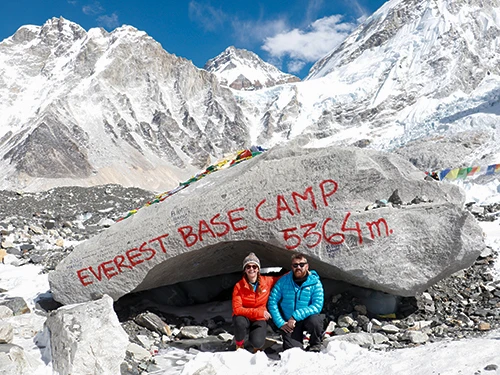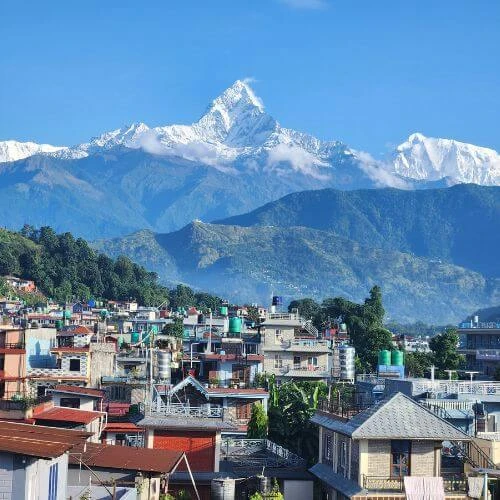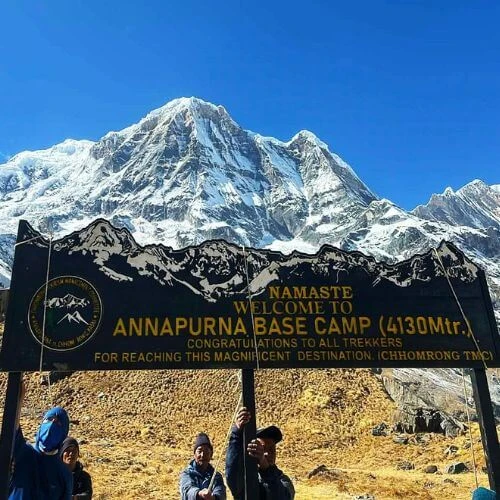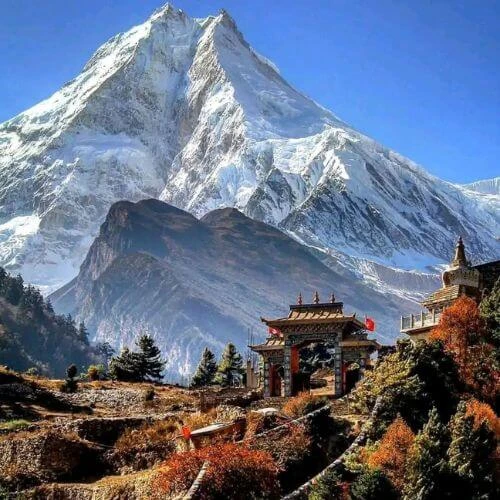The Everest Base Camp (EBC) trek offers trekkers an incredible adventure, taking them deep into the heart of the Himalayas and allowing them to experience the breathtaking view of the world's highest mountains up close. Everest Base Camp sits at an altitude of 5,364 meters (17,598 feet), which leads to the perception that it is an extremely difficult trek. However, considering the high altitude, its difficulty level is not as daunting as it may seem. When approached properly, one can categorize it as moderately difficult, making it accessible to a wide range of trekkers. The entire journey to reach Everest Base Camp usually begins from Lukla, which is roughly 62 kilometers (38 miles) away from the base camp. Overall, trekkers cover about 130 kilometers (80 miles) on a round trip.
The journey to Everest Base Camp is a multi-day trek that requires a good level of physical fitness and mental determination. You'll be trekking for several hours each day, navigating through rugged terrain, steep inclines, and challenging weather conditions. One of the biggest challenges is the high altitude, as you gradually ascend to higher elevations, with the highest point being Kala Patthar at 5,545 meters (18,192 feet) above sea level. At such heights, the air is thinner, making it harder to breathe and increasing the risk of altitude sickness.
To combat the effects of altitude, it's crucial to take your time and allow your body to acclimatize properly. This means taking rest days and not pushing too hard too fast. Your experienced guides will know the best way to manage the ascent, ensuring you have the best chance of reaching your goal without any major issues.

The terrain itself adds to the difficulty of the EBC trek. You'll be trekking over rocky paths, navigating suspension bridges, and sometimes even crossing icy trails. While you don't need to be an expert mountaineer, a decent level of physical fitness and a good pair of hiking boots are essential.
Even with all the difficulties, the EBC trek is not impossible to accomplish. People of all ages and fitness levels, including a remarkable four-year-old child, have completed this journey. It's all about proper preparation, determination, and taking it one step at a time.
As you make your way toward Everest Base Camp, you'll navigate through diverse landscapes, including lush valleys, ancient monasteries, and towering peaks. The trek offers manifold rewards, from experiencing stunning views of Mount Everest and the surrounding peaks to engaging in rich cultural experiences with the warm and hospitable Sherpa community. Upon reaching Everest Base Camp, you'll feel overwhelmed by a sense of accomplishment and awe, making all the hard work and determination worth it.

Challenges during the Everest Base Camp trek
Altitude sickness
Altitude sickness is one of the biggest challenges trekkers face during the Everest Base Camp (EBC) trek. As trekkers ascend to high altitudes, the air thins, and the availability of oxygen decreases. This lack of oxygen can cause various symptoms collectively known as altitude sickness. Common symptoms include headaches, dizziness, nausea, fatigue, and shortness of breath. In severe cases, altitude sickness can escalate to life-threatening conditions like pulmonary or cerebral edema. To prevent altitude sickness, trekkers must ascend gradually, allowing their bodies to adjust to the decreasing oxygen levels. Proper acclimatization, staying hydrated, and avoiding strenuous activities at high altitudes can help mitigate the effects of altitude sickness and ensure a safer and more enjoyable EBC trek.

Extreme weather conditions
The weather in the Everest region can be very harsh and unpredictable, making it tough for trekkers. Heavy snowfall and blizzards often hit without warning. Temperatures can drop below freezing, even during the day. Strong winds can make it feel even colder and blow freezing snow into trekkers' faces. Sudden weather changes from sunny to snowy are common. This extreme weather requires trekkers to carry very warm clothing and gear to stay safe. Trekkers must prepare for snow, ice, high winds, and sub-zero temperatures at all times. The intense cold and severe storms make walking extremely difficult and increase risks like frostbite and hypothermia. Dealing with such brutal and rapidly changing weather is one of the biggest challenges of this famous high-altitude trek.
Difficult terrain
The path to Everest Base Camp presents numerous challenges. Trekkers encounter rough and uneven trails with lots of rocks and boulders. They must scramble up and down steep sections in certain areas using their hands. Narrow edges along cliff sides pose potential dangers with one misstep. Trekking involves crossing several high mountain passes exceeding 5,000 meters above sea level, covered in deep snow and ice.
Additionally, trekkers navigate rocky glacial moraines and piles of debris from glaciers. Constant uphill and downhill walking is exhausting, particularly at high altitudes with reduced oxygen levels. The demanding terrain necessitates trekkers to maintain a high level of physical fitness, use appropriate trekking gear like trekking poles, and possess the stamina to endure each challenging day on the trail.

Limited facilities
Along the Everest Base Camp trek route, trekkers stay in basic teahouses or lodges with minimal amenities. The lodges provide small rooms with just wooden beds and thin mattresses. Hikers endure the biting cold as most lodges lack insulation and heating systems. With no running water available, they must use shared bathroom facilities with pit toilets. Dining choices are extremely limited, as the teahouses serve repetitive basic meals of rice, lentils, and potato dishes daily. While hot showers and wifi are offered, trekkers need to pay an extra 5-7 USD to access these luxuries, which most cannot afford daily for weeks. Coping with such restricted facilities adds an extra layer of challenge to this demanding high-altitude adventure.
Psychological challenges
The EBC trek tests trekkers' mental toughness as much as their physical endurance. The extreme isolation from being in a remote, sparsely populated region for weeks weighs heavily on the mind. Trekkers face the persistent challenges of altitude sickness, freezing temperatures, and exhausting climbs day after day. They push their bodies to the limit, battling fatigue and muscle soreness with each challenging step. The lack of familiar comforts and feeling disconnected from the outside world adds to the psychological strain. The constant uncertainty about the rapidly changing mountain weather heightens anxiety. Staying motivated through such challenging conditions requires remarkable willpower and determination. Overcoming these mental challenges becomes a significant test of trekkers' inner strength during this remarkable journey.
Recommendation Read: Annapurna Circuit vs Everest Base Camp Trek
Cultural Differences
On the EBC trek, hikers encounter people from various cultures and backgrounds, both locals and fellow trekkers. Respecting and adapting to these cultural differences can be challenging. With locals in Sherpa villages, hikers must follow different customs like dressing modestly and avoiding offensive gestures. Communication barriers due to language differences make simple interactions difficult. Among other trekking groups, hikers come across diverse nationalities with varying beliefs, behaviors, and expectations. Dietary restrictions, personal habits, and social norms may contrast with one's own. Some may prioritize the journey's physical demands, while others emphasize the spiritual experience. Disagreements or tensions can arise from such cultural gaps. Remaining open-minded and respectful in these situations requires patience and understanding.

Things to Consider while trekking to Everest Base Camp
Acclimatization
When preparing for the Everest Base Camp trek, it's crucial to understand the significance of acclimatization to higher altitudes. As you ascend, the air becomes thinner, and your body requires time to adjust to the reduced levels of oxygen. Acclimatization, therefore, becomes a vital aspect of the trek. It involves gradually adapting to the high altitude conditions. Taking it slow and allowing your body to acclimatize properly is essential. Rushing the trek can increase the risk of altitude sickness, which poses serious dangers. It's imperative to listen to your body and not hesitate to take an extra day or two for acclimatization if you start feeling the effects of altitude. Incorporating adequate acclimatization into your Everest Base Camp trek preparation ensures a safer and more enjoyable experience.
Stay hydrated
At higher altitudes, where the air is dry and physical exertion is increased, it's easy to become dehydrated without even realizing it. Drinking plenty of water is crucial to prevent altitude sickness, headaches, and fatigue. Carry a reusable water bottle or hydration pack and refill them frequently. Avoid drinking too much caffeine or alcohol, as these can contribute to dehydration. Pay attention to the color of your urine – it should be light yellow or clear, indicating proper hydration.

Dress in layers
When embarking on the Everest Base Camp (EBC) trek, dressing in layers is essential. This means wearing several lightweight clothing items that you can easily add or remove as temperatures change along the journey. Layering helps regulate body temperature, keeping you warm during chilly mornings and evenings, while allowing you to stay cool during strenuous uphill climbs or warmer weather. It's important to have a moisture-wicking base layer to keep sweat away from your skin, insulating mid-layers for warmth, and a waterproof outer layer to protect against wind and rain. By dressing in layers, you'll stay comfortable and prepared for the unpredictable weather conditions encountered on the EBC trek.
Follow the lead of your guide
Following the lead of your guide is essential during the Everest Base Camp (EBC) trek. Guides are experienced and knowledgeable about the route, altitude effects, and potential dangers along the way. They know the best paths to take, where to rest, and how to handle emergencies. By listening to your guide and following their instructions, you can stay safe, prevent accidents, and make the most of your EBC trekking experience. Their guidance ensures you navigate the challenges effectively, increasing your chances of reaching the base camp safely. Additionally, as of April 1, 2023, all foreign trekkers in Nepal must adhere to a new rule mandating the presence of a licensed guide, whether local or porter, during their trek. This regulation applies to solo trekkers as well as groups, underscoring the importance of having professional guidance for a successful and compliant journey.

Monitor your health
Trekking to EBC involves navigating challenging high-altitude terrain. It's crucial to monitor your health closely during the trek. Watch out for symptoms of altitude sickness, such as headaches, nausea, dizziness, or difficulty breathing. Drink plenty of water, take it slow, and allow your body to acclimatize. If you feel very sick, get down to a lower altitude right away. Take note of your body's needs and avoid overexerting yourself.
Carry essential gears
Proper preparation for the Everest Base Camp trek plays a crucial role in ensuring a safe and comfortable journey. Packing warm and waterproof clothing, sturdy trekking boots, a comfortable backpack, and lightweight camping equipment are essential. Additionally, bringing along essential items such as a first-aid kit, sunscreen, sunglasses, a water bottle, and energy-rich snacks is important. It's crucial not to overlook the necessity of packing a good quality sleeping bag and a sturdy trekking pole to aid in navigating the challenging terrain. The appropriate equipment can greatly improve your entire trekking experience.
Pace yourself
The trek to EBC is not a race; it's a journey that requires patience and a steady pace. Going too fast can lead to exhaustion and increase the risk of altitude sickness. Take your time, walk slowly, and maintain a comfortable rhythm. Stop frequently to catch your breath, hydrate, and admire the stunning Himalayan scenery. Rushing will only drain your energy reserves and make the trek more challenging. Listen to your body, and adjust your pace according to how you feel. Remember, the goal is to reach EBC safely, not to set any speed records.

How to train for the Everest Base Camp trek
Cardiovascular Endurance:
The Everest Base Camp trek requires you to hike for long hours at high altitudes. To build the necessary cardiovascular endurance and physical fitness for the EBC trek, engage in activities like running, cycling, or hiking for several months before the trek. Gradually increase the duration and intensity of your workouts to prepare your body for the demands of the trek.
Strength Training:
Strong legs are essential for navigating the steep and uneven terrain during the trek. Incorporate exercises like squats, lunges, and calf raises into your training routine to build leg strength and endurance. This will help you tackle the challenging terrain with ease.

Hiking Practice:
The best way to prepare for the Everest Base Camp trek is to go on practice hikes. If possible, choose hilly or mountainous terrain to simulate the conditions you'll encounter during the trek. Start with shorter hikes and gradually increase the distance and elevation gain to build endurance.
Altitude Training:
Training for the Everest Base Camp trek involves more than just physical preparation; it also requires acclimatization to high altitudes. The high altitudes encountered during the trek can be challenging for those who are not accustomed to them. If possible, it's advisable to spend some time at higher altitudes before embarking on the trek. This helps your body adjust to the lower oxygen levels and reduces the risk of altitude sickness during the actual journey. Therefore, incorporating altitude acclimatization into your training regimen is essential for a successful Everest Base Camp trek.
Flexibility and Balance:
Incorporating exercises like yoga or Pilates into your training routine can improve your flexibility and balance. Good balance and flexibility will help you navigate the uneven terrain with ease and reduce the risk of injury during the trek.
Pack Weight Training:
During the Everest Base Camp trek, you'll be carrying a backpack with your personal belongings and gear. Practice hiking with a backpack loaded with weight similar to what you'll be carrying during the trek. This will help you get used to the added weight and build the necessary strength.

Conclusion
Trekkers who take on the Everest Base Camp trek need to be well-prepared both physically and mentally. The high altitudes require slow and steady climbing to avoid getting sick. The rocky, uneven trails and frequent uphill and downhill sections demand strong legs and endurance training. Trekkers should pack the right gear like warm layers, trekking poles, and sturdy boots. They must also have the mental toughness to push through fatigue, muscle soreness, extremely cold weather, and basic lodging conditions along the trek. While very difficult, reaching Base Camp provides an amazing sense of accomplishment after overcoming all the challenges like isolation, lack of amenities, and cultural differences.

For those willing to properly train their body, and mind, and respect the high Himalayan environment, the Everest Base Camp trek proves to be an achievable and life-changing experience surrounded by incredible mountain scenery. With proper pacing and care, determined trekkers can meet moderate physical and mental demands.
Recommendation Read:
Top 10 Reasons to Do Everest Base Camp Trek
Check Our Other Everest Base Camp Trek Packages
Everest Chola Pass Trek | Everest Three Passes Trek | Everest Base Camp Short Trek | Lhasa Tour with EBC | Tibet EBC Trek | Everest Helicopter Tour | Everest Base Camp Trek
Learn More About Everest Base Camp
EBC Trek Map | Safety on EBC Trek | Acclimatization on EBC Trek | How Long Is EBC Trek | Everest Base Camp vs Annapurna Circuit | EBC Trek vs EBC Mountain Flight | EBC Packing List | Permits Necessary for EBC Trek | Reasons To Do EBC Trek | Best Time for EBC Trek
FAQs
How hard is the Everest Base camp trek?
The Everest Base Camp trek is moderately difficult, requiring a reasonable level of fitness and endurance to navigate its varied terrain and altitude challenges.
What is the best time to trek to Everest Base Camp?
The best time to trek to Everest Base Camp is https://aboundholidays.com/blog/best-time-for-everest-base-camp-trek Best time for Everest Basecamp Trek is during the spring (March to May) and autumn (September to November) seasons, when the weather is generally stable, skies are clear, and the views of the Himalayas are spectacular.
How long does it take to reach Everest Basecamp?
The trek typically takes around 12 to 14 days, depending on the route and acclimatization schedule.
What are the Permits required for the Everest Basecamp trek?
Trekkers need to obtain a Sagarmatha National Park permit and a TIMS (Trekkers' Information Management System) card before starting the trek.




 based on 5 reviews
based on 5 reviews












